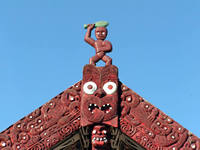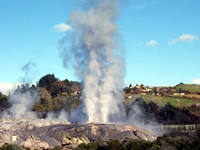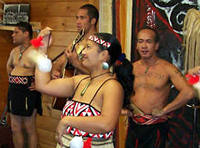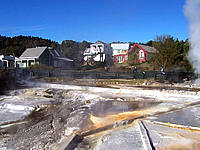|
Rotorua
Thermal Wonderland
Photos
of Rotorua
Adventure
Photos of Rotorua
Wai-o-tapu
Waimangu
Sightseeing,
Tours, Attractions and Events in Rotorua
Hotels
and Accommodation in Rotorua
By
Richard Moore
 If you want to see one of the most amazing places to live, then
take a trip to Whakarewarewa at Rotorua in New Zealand's North Island.
If you want to see one of the most amazing places to live, then
take a trip to Whakarewarewa at Rotorua in New Zealand's North Island.
It is a community of around 70 families that live among hotpools,
geysers and boiling mud pools - not to forget being a major stopping-off
point for busloads of arriving tourists.
Walking
through the gates of Whakarewarewa you think it is just going to
be another thermal attraction, but as you move around - with or
without guide - you are hit by the fact that there are people's
homes nestled in and around the steaming pools.
Washing
hangs out on lines and people stand around talking, usually oblivious
to the Japanese schoolgirls or Australian tour parties that wander
around.
 The
members of the Tuhourangi - Ngati Wahiao, a Maori family group,
have been around Whakarewarewa for more than three centuries and
their ancestors moved into the area after the 1886 explosion that
destroyed much of Mt Tarawera and the fabled pink and white terraces. The
members of the Tuhourangi - Ngati Wahiao, a Maori family group,
have been around Whakarewarewa for more than three centuries and
their ancestors moved into the area after the 1886 explosion that
destroyed much of Mt Tarawera and the fabled pink and white terraces.
The
main attraction at Whakarewarewa is the Pohutu geyser, a truly impressive
water spout that shoots boiling water up to 30 metres into the air.
It erupts once or twice an hour and usually lasts up to three minutes.
Nearby
is the smaller, but still interesting Prince of Wales geyser that
gets its name from the shape of its spouts looking like the feathers
on the royal coat of arms.
One
of the much-talked about attractions at Whakarewarewa is the penny
diving, where local boys jump off a bridge to retrieve coins thrown
in by visitors. It may be work to them, but it sure looks like a
lot of fun.
 Out
the back of the village - about 10 minutes walk along a pathway
- is a small green lake known as Emerald Lake. It is remarkably
peaceful there and you can get close to some small mud pits along
the way. Out
the back of the village - about 10 minutes walk along a pathway
- is a small green lake known as Emerald Lake. It is remarkably
peaceful there and you can get close to some small mud pits along
the way.
If
you want to see the darker side of thermal areas then take a slight
detour from that path and wander across a wooden walkway through
an area that could be part of Dante's vision of purgatory.
The
ground is grey and rocky and the mud dark. Steam eerily moves off
a small lake while more seeps out of some very mean looking holes
in the ground.
Signs
say cross at your own risk and you can understand how people could
be a bit leery of it. But, it has to be said, it was this part of
Whakarewarewa that grabbed my fancy more than the other areas because
it truly suggested the primeval side of thermal areas.
 Visitors
can also get to hear a local tribal welcome and then listen to a
small concert performed by the local folk. The singing is terrific
and the audience while I was there was very appreciative of the
cultural aspect of Whakarewarewa. Visitors
can also get to hear a local tribal welcome and then listen to a
small concert performed by the local folk. The singing is terrific
and the audience while I was there was very appreciative of the
cultural aspect of Whakarewarewa.
The shows go for around 30 minutes and begin at 11:15 am and 2:00
pm. While there you really should try the Maori style cooking of
the hangi, where the food is steamed buried underground or in the
hot pools themselves.
It
is a delicious treat - and beats Weight Watchers hands down!
Now
Whakarewarewa is not the most impressive of the thermal areas to
tour in Rotorua - it lacks the spectacular colours of Wai-o-tapu
and the prehistoric feel of Waimangu
- but, if you have an hour or so to spare, it is worth visiting
to see Pohutu and how a community lives in such a rare area.
Tickets
Adults $20
Children 5-12 years $10
Group Discount (10+) $17 per person
Family Pass (2 Adults & 1-4 kids) $50
Hours of Opening 8.30am to 5pm everyday, except Christmas Day.
|



